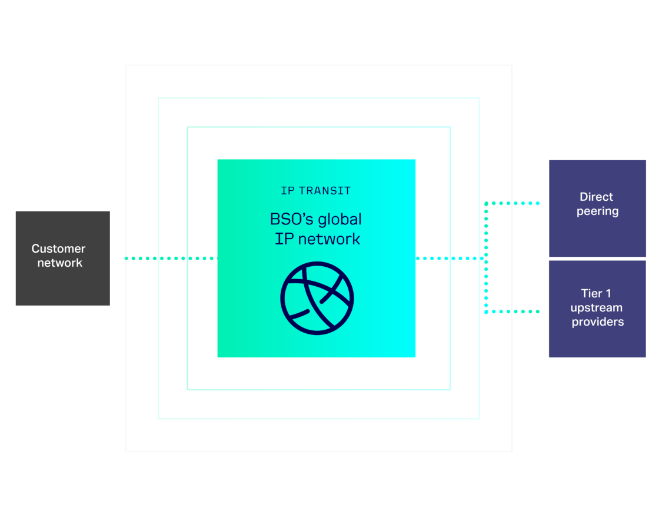PRODUCTS
IP Transit_
Dependable global access_
The market is inundated with IP Transit services; some ultra-premium, others racing to the bottom. BSO’s high-quality, cost-effective IP Transit solution caters to all.
OUR SERVICE
Fast, reliable, maximum redundancy_
P Transit is built through a combination of learned routes and upstream connectivity. BSO has 300,000+ routes to choose from and we work with best-in-class Tier 1 carriers to supply our upstream. BSO IP Transit is available at 100Mbps to 40Gbps across multiple regions.

Service options_
Full transit
Routes from our own global network and Tier 1 partners - a complete IP Transit BGP service.
Partial transit
Direct routes only, a great addition to an existing IP Transit BGP service.
Out-of-band (OOB)
10Mbps connection with included /30 to manage remote networking equipment.
Direct internet access (DIA)
Direct feed to the Internet with an included /30 and the ability to add more IP addresses. No ASN required.
OUR DIFFERENCE
Why BSO for IP Transit?
Route Coverage
We directly peer with thousands of networks providing the most direct access for customers.
Resilience
Our direct routes and multiple upstream connections ensure complete diversity.
Bundle friendly
IP Transit’s competitive rates make it a compelling add-on to existing BSO ports.
PRODUCT SHEET
BSO's IP Transit product sheet_
Grow faster with our relevant products_
Get in touch to connect better with IP Transit_
FAQs
How does IP Transit work?
IP Transit works by establishing a connection between an organisation's network and an upstream ISP, advertising the organisation's IP address prefixes, and using BGP to exchange routing information with other networks on the internet. This enables global reach, allowing users and devices worldwide to access services hosted by the organisation while routing traffic efficiently across the internet.
Here's how it works in more detail:
Network connection: An organisation, typically an Internet Service Provider (ISP), data centre, or large enterprise, establishes a connection to an upstream Internet Service Provider or a Tier-1 ISP. This connection is often made through a high-capacity link or multiple links for redundancy.
Routing: The organisation's network advertises its IP address prefixes (blocks of IP addresses it owns) to its upstream ISP. This is done through Border Gateway Protocol (BGP), a routing protocol used to exchange routing and reachability information between autonomous systems (ASes) on the internet.
BGP peering: The upstream ISP, which is well-connected to various other networks and the core of the internet, accepts these advertised IP prefixes and announces them to its peers and other networks it connects to. BGP peering relationships are established with other ISPs and networks to facilitate this routing information exchange.
Global reach: As BGP updates propagate across the internet, the organisation's IP address prefixes become reachable by all other networks on the internet. This means that any device connected to the internet can send traffic to or receive traffic from the organisation's IP addresses.
Data exchange: When a user or device on the internet wants to access a service hosted by the organisation (e.g. a website or email server), their traffic is routed through a series of ISPs and networks based on BGP routing tables. Eventually, it reaches the upstream ISP connected to the organisation.
Traffic forwarding: The upstream ISP forwards the incoming traffic to the organisation's network through the established connection. The organisation's network processes the traffic, which may include delivering web pages, emails, or other services.
Return traffic: Likewise, when the organisation's network responds to incoming requests, it sends its outbound traffic back through the upstream ISP, which then routes it to the appropriate destination on the internet based on BGP routing.
Billing and peering agreements: The organisation typically pays its upstream ISP for the volume of traffic it sends and receives through the IP transit service. Peering agreements, which can be settlement-free or paid, govern how ISPs exchange traffic with each other to ensure equitable connectivity.
What is an IP Transit service?
An IP transit service is a fundamental internet connectivity offering provided by Internet Service Providers (ISPs). It allows organisations and networks to gain access to the global internet. With IP Transit, an organisation connects to an upstream ISP, typically over high-capacity links, and advertises its IP address prefixes. This enables the organisation to exchange data with all other networks connected to the internet. In essence, IP transit serves as the gateway that connects your network to the vast web, enabling users and devices to access online content and services while facilitating the flow of data in and out of your network on a global scale.
What is the capacity of IP Transit?
The capacity of BSO IP Transit is highly flexible and designed to meet diverse connectivity needs. This service combines learned routes and upstream connectivity, boasting access to over 300,000 routes and partnerships with Tier 1 carriers to ensure robust and reliable performance.
BSO IP Transit is available across multiple regions, offering a wide range of bandwidth options, ranging from 100 Mbps to 40 Gbps. This flexibility enables organisations to choose the specific capacity that aligns with their internet connectivity requirements, and as needs evolve, the service is scalable to accommodate growing internet traffic and changing business demands.
What is the difference between BGP and IP Transit?
BGP (Border Gateway Protocol) and IP Transit are related but distinct concepts in networking:
BGP (Border Gateway Protocol): BGP is a routing protocol used to exchange routing and reachability information between autonomous systems (ASes) on the internet. It's responsible for determining the best path for data packets to travel from one network to another. BGP is essential for routing decisions and is used by network administrators to control the flow of traffic within and between ASes. BGP is a protocol.
IP Transit: IP transit, on the other hand, is a service provided by Internet Service Providers (ISPs) that allows organisations to connect to the global internet. It involves establishing a network connection with an upstream ISP, which in turn connects your network to the broader internet. IP transit provides global reach, allowing users and devices to access online content and services while facilitating the flow of data in and out of your network. IP Transit is a service.
In summary, BGP is a routing protocol used to determine the best paths for data packets, while IP transit is a service that connects your network to the internet, allowing the exchange of data with the rest of the world. BGP is a technology used within IP transit services to manage the routing of traffic.
What are the benefits of IP Transit?
IP transit is an essential service for organisations looking to establish a robust internet presence and efficiently manage their network traffic. It offers several significant benefits such as:
Global connectivity: IP transit provides access to the global internet, enabling users and devices to reach online content and services worldwide. This global reach is essential for businesses, content providers, and organisations with a global presence.
Reliability: By connecting to multiple upstream ISPs and using BGP routing, IP transit enhances network redundancy and reliability. If one connection or ISP experiences issues, traffic can be rerouted through alternative paths, ensuring uninterrupted internet access.
Scalability: IP transit services come in various bandwidth options, allowing organisations to scale their internet connectivity based on their evolving needs. This scalability ensures that you can accommodate increasing internet traffic and growth without major infrastructure changes.
Control: IP Transit provides organisations with control over their routing policies and the ability to optimise traffic flow. This control is crucial for ensuring efficient and secure data transfer.
Performance: With direct peering and optimised routing, IP transit can reduce latency and improve the performance of internet connections. Faster access to online resources enhances user experiences and productivity.
Resilience: IP transit services often include redundant connections and diverse routing options, reducing the risk of network downtime due to failures or network congestion.
Flexibility: Organisations can choose from various service options, including full transit, partial transit, out-of-band connections, and direct internet access (DIA), to tailor their IP transit service to their specific needs.
Cost-efficiency: IP transit can be cost-effective compared to alternatives like colocation. It eliminates the need for organisations to maintain data centre infrastructure and can offer competitive pricing for high-speed internet connectivity.
Market expansion: IP transit enables quicker access to new markets and networks, facilitating business expansion and the ability to reach a wider audience.





/Revolutionising-Connectivity%20BSOs-Tailored-Cloud-Solution-for-CryptoStruct-GmbH.png?width=1050&height=550&name=Revolutionising-Connectivity%20BSOs-Tailored-Cloud-Solution-for-CryptoStruct-GmbH.png)
/6%20Cloud%20Best%20Practices%20for%20Financial%20Technology%20Companies.jpg?width=1200&height=600&name=6%20Cloud%20Best%20Practices%20for%20Financial%20Technology%20Companies.jpg)




